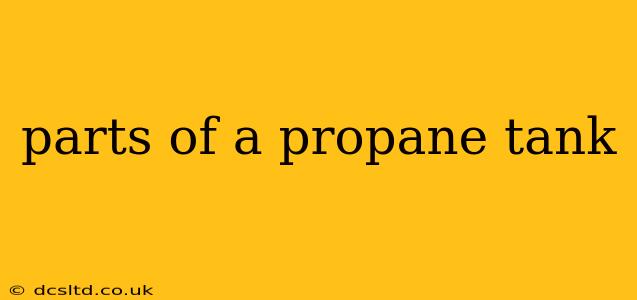Decoding the Anatomy of a Propane Tank: A Comprehensive Guide
Propane tanks, those ubiquitous cylinders holding the fuel for barbecues, home heating, and countless other applications, are more complex than they appear. Understanding their components is crucial for safe and efficient use. This guide delves into the various parts of a propane tank, explaining their function and importance.
What are the main components of a propane tank?
A propane tank's design is surprisingly straightforward, yet each part plays a vital role in its safe operation. The main components include:
-
Cylinder: This is the primary body of the tank, a robust steel container designed to withstand significant pressure. The thickness and material of the cylinder are crucial for safety, complying with stringent regulations. The cylinder's construction often involves a seamless welded design to minimize potential weak points.
-
Valve: Situated at the top of the cylinder, the valve controls the flow of propane gas. This is arguably the most critical safety component, preventing accidental releases. Propane valves typically include a handwheel for manual operation and various safety features like an overpressure relief valve.
-
Overfill Protection Device (OPD): Integrated into the valve assembly, the OPD prevents overfilling the tank. This safeguards against dangerous pressure buildup. It's a crucial safety feature mandated by regulations to prevent accidents.
-
Protective Coating: Most propane tanks are coated with a protective layer of paint or powder coating. This layer safeguards the steel cylinder from corrosion and extends its lifespan. The quality of the coating is essential for preventing rust and maintaining the tank's integrity.
-
Collar/Neck Ring: The collar or neck ring is the slightly raised area around the valve assembly. It provides a stronger structural element around the valve, protecting it from damage.
-
Foot Ring (for larger tanks): Larger propane tanks, often used for residential heating, typically feature a foot ring at the base. This enhances stability and makes handling and transportation easier.
What are the different types of propane tanks?
Propane tanks come in various sizes and types, each suited to specific applications:
-
Small, Disposable Tanks: These are commonly found in portable grills and are typically single-use. Once empty, they are disposed of and replaced.
-
Refillable Tanks: These larger tanks are refillable at propane filling stations and are frequently used for home heating, industrial applications, or larger outdoor grills.
-
Bulk Tanks: Extremely large tanks, these are usually installed permanently for large-scale applications like powering commercial buildings or fueling fleets of vehicles.
How does a propane tank work?
A propane tank functions by storing liquefied propane under pressure. The pressure keeps the propane in a liquid state even at ambient temperatures. When the valve is opened, the liquid propane vaporizes, turning into gas and flowing out to the appliance. The pressure inside the tank remains relatively constant until the tank is nearly empty.
What are the safety features of a propane tank?
Safety is paramount when dealing with propane. Several crucial features contribute to minimizing risks:
-
Pressure Relief Valve: This valve is designed to release excess pressure if the tank becomes overheated or subjected to extreme conditions, preventing a potentially dangerous explosion.
-
Overfill Protection Device (OPD): As mentioned above, this device prevents overfilling, reducing the risk of pressure buildup.
How do I know if my propane tank needs to be replaced?
Several signs indicate a propane tank may need replacement:
-
Significant Rust or Corrosion: Extensive rust compromises the tank's integrity, posing a safety hazard.
-
Visible Damage: Dents, cracks, or other damage to the cylinder require immediate replacement.
-
Expiration Date (for some tanks): Some tanks have an expiration date stamped on them. Tanks past this date should be replaced.
This comprehensive guide aims to provide a detailed understanding of propane tank components and their importance. Remember, safety should always be the top priority when handling propane tanks. Regular inspection and adherence to safety guidelines are essential for preventing accidents.
